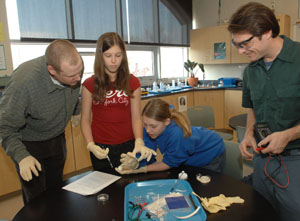Ordinarily, the last thing teachers want is their students hanging out the classroom windows. Especially when they’re four floors up.
However, Scott McClintock, who teaches seventh-grade science at Maplewood Richmond Heights Middle School, isn’t an ordinary science teacher.
He believes that connecting his students to critical issues in their world is the key to helping them learn. And that means that if leaning out the window to collect readings on light levels from the sun, he encourages it. (And since the window has a third floor roof directly under it, the students aren’t taking any safety risks.)
Washington University in St. Louis graduate and undergraduate students, as part of WUSTL’s Science Outreach program, recently helped McClintock and his students complete a diverse study of wind energy, biomass, solar power and hydropower, spending an entire week with four different classes.
Joseph Springer and Michelle Harris, graduate students in chemistry in Arts & Sciences, helped students Feb. 16 construct dye-sensitive solar cells using titanium dioxide, an inexpensive pigment used to color white paint. Springer and Harris conduct research on these types of cells to help determine ways to harvest light from solar energy systems.
“I enjoy seeing the kids get excited over renewable energy,” Harris says. “And I get excited about it as if I’m learning it for the first time myself. Sometimes, it’s really helpful for us to get out of the lab, because you can get stuck!” she laughs.
Harris works in the lab of Dewey Holten, PhD, professor of chemistry, one of the principal investigators who are part of the Photosynthetic Antenna Research Center (PARC), an international collaborative of researchers that is based at WUSTL.

David Kilper
WUSTL graduate student Joseph Springer (right) helps 7th graders Sarah Robberson (second from left) and Marianne Hicks under the watchful eye of their teacher, Scott McClintock.
McClintock planned the unit on renewable energy when he learned about materials at teacher workshops at Washington University.
Three workshops, held in fall 2010 and winter 2011, were sponsored by Science Outreach, PARC and the Howard Hughes Medical Institute. The workshops gave teachers an opportunity to learn about investigations they can do with their students to investigate solar energy, wind energy, hydropower and fuels from biodegradable materials.
Rachel Ruggirello, science educator with WUSTL’s Science Outreach and PARC, created investigations in renewable energy that are suitable for middle and high school science. Energy is a topic that links biology, chemistry and physics through problems like those studied by research scientists. And it addresses real challenges faced by all in daily life.
“Having all the materials right there in the kits makes it possible for teachers to do these units,” Ruggirello says. She wrote a grant to the Toshiba America Foundation for classroom sets of the equipment, which includes solar collectors, wind turbines, testing kits and other materials. Teachers who participated in the workshops can check out classroom sets of the materials to use with their students.
McClintock says he’s grateful for the materials, and for the support from the WUSTL students. “I bit off more than I can chew,” he laughs. “It’s great to have experts in the field (from WUSTL) here. And my students know they are doing something that has real world applications, and that it’s not just about a lab activity and a grade.”
McClintock’s students are taking their findings from science class and developing a community calendar that will feature each type of renewable energy. They are producing it entirely themselves, including marketing it.